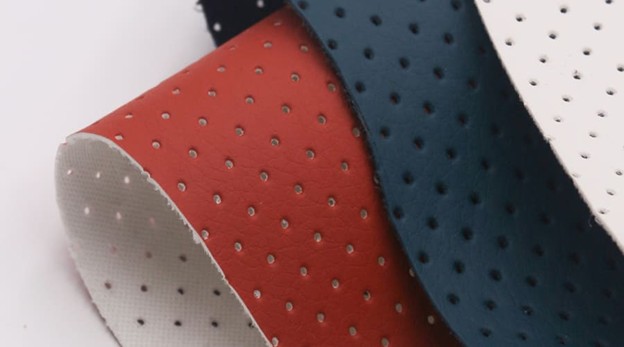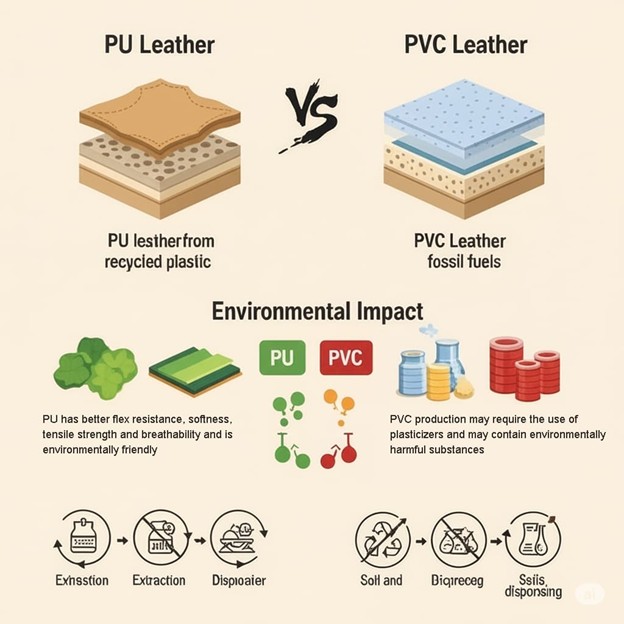The Differences Between PU, CU, PVC, and Faux Leather

In the evolving world of materials and textiles, synthetic leather has emerged as a popular alternative to natural hide due to its affordability, versatility, and ethical appeal. Among the most commonly used synthetic leather types are PU (Polyurethane), CU (Composite), PVC (Polyvinyl Chloride), and general faux leather. Each variant has unique properties, applications, and benefits that make it suitable for different industries. In this article, we’ll explore the key differences between PU, CU, PVC, and faux leather to help consumers, manufacturers, and designers make informed choices.
Understanding PU Leather: Composition and Characteristics
PU leather, short for polyurethane leather, is a synthetic material made by applying a layer of polyurethane to a base fabric—often polyester or cotton. Unlike genuine leather, PU leather is not derived from animal hides, making it a popular choice for those seeking cruelty-free options. One of the standout qualities of PU leather is its soft, flexible texture, which closely mimics real leather while being more lightweight and breathable.
PU leather is widely used in fashion, upholstery, automotive interiors, and accessories like handbags and belts. It has a smooth finish, good elasticity, and is generally easy to clean, requiring just a damp cloth for maintenance. However, pu leather is not as durable as genuine leather and may peel or crack over time with frequent use.
CU Leather: What Makes It Different?
CU leather stands for composite leather, which is essentially a hybrid material composed of leftover leather fibers mixed with bonding agents like polyurethane. This mixture is then rolled into sheets and coated with a protective synthetic layer. CU leather aims to capture the aesthetics of real leather while reducing waste and production costs.
CU leather is slightly more robust than PU leather due to its partial real leather content, offering better durability and resistance to wear. It’s often used in footwear, furniture, and automotive trims where a balance between cost and performance is needed. However, because it still contains leather particles, CU leather is not considered fully vegan and may not be suitable for ethically-conscious consumers looking for 100% synthetic materials.
PVC Leather: A More Rigid Option
PVC leather, or vinyl leather, is made by coating a base fabric (usually polyester) with a layer of polyvinyl chloride and plasticizers to give it flexibility. This type of synthetic leather has been in use since the 1920s and is known for its water resistance, durability, and resistance to chemicals and fire.
Compared to PU leather, PVC leather is stiffer and less breathable, which can make it less comfortable in applications like clothing or car seats where contact with skin is prolonged. However, its toughness makes it ideal for applications requiring long-lasting material—such as industrial upholstery, outdoor furniture, and marine products. PVC leather is often cheaper to produce but can have a plastic-like appearance and may not feel as premium.
Faux Leather: The Umbrella Term
Faux leather is a broad term that encompasses all types of synthetic leather, including PU, CU, and PVC. It refers to any material designed to simulate the appearance and feel of real leather without using animal hide. Faux leather can be made from various base materials and coatings, with each type offering different textures, finishes, and functional characteristics.
What sets faux leather apart is its environmental and ethical appeal. Consumers who are eco-conscious or oppose animal cruelty often prefer faux leather products. However, it’s important to note that not all faux leather is created equal—some may be more sustainable or skin-friendly than others depending on their chemical makeup and manufacturing process.
Durability and Maintenance Compared
When comparing the durability of PU, CU, PVC, and faux leather, each type offers different lifespans and resistance levels. PVC leather typically lasts the longest due to its resistance to abrasion and harsh conditions. CU leather offers a middle ground, being more durable than PU but not as robust as PVC. PU leather, while comfortable and stylish, tends to show wear and tear sooner, especially under frequent use or sun exposure.
Maintenance-wise, all synthetic leathers are easier to clean than genuine leather. PU leather and PVC can be wiped down with a damp cloth, while CU may require a bit more care due to its composite nature. Harsh cleaners should be avoided, as they can damage the synthetic coating over time. Faux leather in general is less prone to staining, which adds to its appeal in households with pets or children.
Comfort and Aesthetics
PU leather is often favored for applications requiring a softer touch, such as in clothing, handbags, or car interiors. Its flexibility and smooth texture closely mimic real leather, providing a high-end look at a lower cost. CU leather also offers a luxurious appearance but may have slight inconsistencies due to the recycled nature of its base materials.
PVC leather, while highly functional, can appear more rigid and glossy, sometimes giving off a plastic-like finish. It may not offer the same level of comfort in wearables or furniture. In contrast, PU leather can be embossed or dyed in various patterns and colors, offering more creative freedom in design.
Faux leather overall provides a wide aesthetic range, from matte and textured to glossy and metallic finishes. This versatility allows it to cater to both classic and modern design tastes, making it a favorite in fashion and interior design industries.
Environmental Considerations
While faux leather is often marketed as a more eco-friendly alternative to real leather, its environmental impact varies depending on the type. PVC leather, for instance, is less sustainable due to the presence of chlorine and other harmful chemicals in its production. It is also not biodegradable, contributing to long-term landfill waste.
PU leather is slightly more eco-conscious, especially when water-based polyurethanes are used. However, it still involves synthetic polymers and doesn’t biodegrade easily. CU leather, made partly from recycled materials, may offer a slightly better sustainability profile, although its composite nature makes recycling difficult.
Innovations are emerging in the realm of bio-based PU leather and plant-based faux leathers (like those made from pineapple leaves or mushroom mycelium), but these are still in early stages of adoption. Conscious consumers are encouraged to look for certifications or brands committed to sustainable practices when shopping for faux leather products.
Cost and Accessibility
One of the primary reasons synthetic leathers like PU leather have gained popularity is their affordability. PU leather typically costs significantly less than genuine leather, making it accessible for a broader range of consumers and manufacturers. CU and PVC leather are similarly cost-effective, with prices varying based on quality, thickness, and finishing.
PVC leather is generally the cheapest option, but it may lack the aesthetic sophistication of PU or CU. Faux leather in general offers a good value proposition—affordable, widely available, and suitable for various applications. This accessibility has made synthetic leather the material of choice for mass-market fashion brands, home décor companies, and automobile manufacturers worldwide.
Choosing the Right Material for Your Needs
When selecting between PU, CU, PVC, and faux leather, the choice ultimately depends on your specific needs, budget, and ethical stance. PU leather is an excellent all-rounder for consumers looking for a balance between cost, appearance, and comfort. It’s ideal for fashion accessories, furniture, and interior applications where softness and aesthetics matter.
CU leather is better suited for those who want added durability and don’t mind some real leather content. PVC leather is perfect for rugged applications that require water resistance and longevity, though it might sacrifice comfort. Meanwhile, the term “faux leather” serves as an inclusive category for consumers exploring synthetic alternatives to animal-based leather.
Understanding the unique attributes of each material type will help you make smarter purchasing decisions—whether you’re a designer sourcing materials or a consumer buying your next faux leather sofa or handbag.
Conclusion
In summary, the world of synthetic leathers offers a wide range of choices, each with its strengths and weaknesses. From the soft and stylish PU leather to the durable PVC and eco-conscious CU options, there’s a synthetic material for every use case. While faux leather as a whole represents a step forward in cruelty-free fashion and production, understanding the distinctions between PU, CU, PVC, and other faux leathers is essential to making informed and ethical decisions. Whether you’re prioritizing aesthetics, sustainability, or budget, knowing the differences ensures your next leather-like product is the right fit for your lifestyle.





